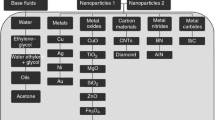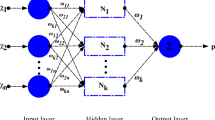Abstract
The current research focuses on identifying machine learning algorithms that provide results with high accuracy. The present work is conducted in three phases: conduction of heat transfer experiments, development of correlation, implementation, and comparison of machine learning algorithms with the correlation. Experiments were conducted using hybrid nanofluids with graphene platelets, and carbon nanotubes dispersed in Ethylene glycol-water mixtures. Ethylene glycol percentage in the base fluid varied from 0 to 100%. The nanoparticles are dispersed in concentrations of 0.5, 0.25, 0.125, and 0.0625 weight fractions. The results achieved a 15 to 24% enhancement in thermal conductivity. Results showed viscosity increased in temperatures ranging from 50 to 70 °C but less in higher temperatures. Correlation formulas were developed, and they predicted the thermal conductivity and viscosity values with a maximum deviation of 10%. Machine learning (ML) models have been implemented, and a comparative analysis with correlation results has been conducted. These ML models provided results with a maximum deviation of 4% for viscosity and 3% for thermal conductivity.









Similar content being viewed by others
Abbreviations
- Cp :
-
Specific heat (kJ/kg K)
- T:
-
Temperature (°C)
- k:
-
Thermal conductivity (W/m K)
- m:
-
Mass flow rate of water (kg/s)
- α:
-
Ethylene glycol volume percentage
- µ:
-
Dynamic viscosity (cP)
- ρ:
-
Fluid density (kg/m3)
- ϕ:
-
Nanoparticles weight fraction
- EG:
-
Ethylene glycol
- CNT:
-
Carbon nanotubes
- GNP:
-
Graphene platelets
- wt%:
-
weight percentage
- ML:
-
Machine learning
- nf :
-
Nanofluids
- bf :
-
Base fluid
References
Assael, M.J., Chen, C.F., Metaxa, I.N., Wakeham, W.A.: Thermal conductivity of suspensions of carbon nanotubes in water. Int. J. Thermophys. 2(25), 971–985 (2004). https://doi.org/10.1023/B:IJOT.0000038494.22494.04
Poongavanam, G.K., Ramalingam, V.: Characteristics investigation on thermophysical properties of synthesized activated carbon nanoparticles dispersed in solar glycol. Int. J. Therm. Sci. 136, 15–32 (2019). https://doi.org/10.1016/j.ijthermalsci.2018.10.007
Dayou, S., Ting, T.W., Vigolo, B.: Comparison of heat transfer performance of water-based graphene nanoplatelet- and multi-walled carbon nanotube-nanofluids in a concentric tube heat exchanger. Diam. Relat. Mater. (2022). https://doi.org/10.1016/j.diamond.2022.108976
Balaji, T., Rajendiran, S., Selvam, C., Mohan Lal, D.: Enhanced heat transfer characteristics of water based hybrid nanofluids with graphene nanoplatelets and multi walled carbon nanotubes. Powder Technol. 394, 1141–1157 (2021). https://doi.org/10.1016/j.powtec.2021.09.014
Shajan, S., Baiju, V., Krishnakumar, T.S., Andrew, G., Thomas, L., Alex, M., Safeer, M.B.: Experimental investigation on thermophysical properties of Therminol® 55 based hybrid nanofluids with alumina and graphene nanoplatelets for medium temperature applications. Therm. Sci. Eng. Prog. (2021). https://doi.org/10.1016/j.tsep.2021.101116
He, Q., Zeng, S., Wang, S.: Experimental investigation on the efficiency of flat-plate solar collectors with nanofluids. Appl. Therm. Eng. 88, 165–171 (2015). https://doi.org/10.1016/j.applthermaleng.2014.09.053
Zetty Akhtar, A.M., Rahman, M.M., Kadirgama, K., Saidur, R., Safiei, W.: Effects of temperature and concentration on thermophysical properties of TiO2-MWCNTs-doped graphene nanofluids. Mater. Today Proc. 48(4), 920–925 (2022). https://doi.org/10.1016/j.matpr.2021.03.725
Can **, Q., Wu, G., Yang, H., Zhang, Zhong, Y.: Investigation on hybrid nanofluids based on carbon nanotubes filled with metal nanoparticles: Stability, thermal conductivity, and viscosity. Powder Technol. 389, 1–10 (2021). https://doi.org/10.1016/j.powtec.2021.05.007
Agarwal, R., Verma, K., Agrawal, N., Singh, R.: Sensitivity of thermal conductivity for Al2O3 nanofluids. Exp. Thermal Fluid Sci. 80, 19–26 (2017). https://doi.org/10.1016/j.expthermflusci.2016.08.007
Sandhya, M., Ramasamy, D., Kadirgama, K., Harun, W.S.W., Saidur, R.: Experimental study on properties of hybrid stable & surfactant-free nanofluids GNPs/CNCs (Graphene nanoplatelets/cellulose nanocrystal) in water/ethylene glycol mixture for heat transfer application. J. Mol. Liq. (2022). https://doi.org/10.1016/j.molliq.2021.118019
Vaisman, L., Wagner, H.D., Marom, G.: The role of surfactants in dispersion of carbon nanotubes. Adv. Coll. Interface Sci. (2006). https://doi.org/10.1016/j.cis.2006.11.007
Huiying Zhang, S., Gao, Y.H., Yuan, X., Ming, T., Ahmadi, M.H., Zhao, X.: Experimental investigation and prediction of changes in thermal conductivity of carbon nanotube nanofluid. Int. Commun. Heat Mass Transfer (2021). https://doi.org/10.1016/j.icheatmasstransfer.2021.105526
Al-Janabi, A.S., Hussin, M., Abdullah, M.Z., Ismail, M.A.: Effect of CTAB surfactant on the stability and thermal conductivity of mono and hybrid systems of graphene and FMWCNT nanolubricant. Coll. Surf. A (2022). https://doi.org/10.1016/j.colsurfa.2022.129275
Rosca, I.D., Watari, F., Uo, M.: Oxidation of multiwalled carbon nanotubes by nitric acid. Carbon 43(15), 3124–3131 (2005). https://doi.org/10.1016/j.carbon.2005.06.019
Zhang, H., Cheng, H.M., Li, H.X.: Water-soluble multiwalled carbon nanotubes functionalized with sulfonated polyaniline. J. Phys. Chem. B 110(18), 9095–9099 (2006). https://doi.org/10.1021/jp060193y
Ding, Y., Alias, H., Wen, D., Williams, R.A.: Heat transfer of aqueous suspensions of carbon nanotubes (CNT nanofluids). Int. J. Heat Mass Transf. 49(1–2), 240–250 (2006). https://doi.org/10.1016/j.ijheatmasstransfer.2005.07.009
Yang, Y., Zhang, Z.G., Grulke, E.A., Anderson, W.B.: Heat transfer properties of nanoparticle-in-fluid dispersions (nanofluids) in laminar flow. Int. J. Heat Mass Transf. 48(6), 1107–1116 (2005). https://doi.org/10.1016/j.ijheatmasstransfer.2004.09.038
Aviles, F., Cauich, J., Moo-Tah, L., May Pat, A.: Evaluation of mild acid oxidation treatments for MWCNT functionalization. Carbon 47(13), 2970–2975 (2009). https://doi.org/10.1016/j.carbon.2009.06.044
Zafar Said, P., Sharma, S., Sundar, L., Afzal, A., Li, C.: Synthesis, stability, thermophysical properties and AI approach for predictive modelling of Fe3O4 coated MWCNT hybrid nanofluids. J. Mol. Liq. (2021). https://doi.org/10.1016/j.molliq.2021.117291
Zafar Said, N.K., Cakmak, P., Sharma, S., Sundar, L., Inayat, A., Keklikcioglu, O., Li, C.: Synthesis, stability, density, viscosity of ethylene glycol-based ternary hybrid nanofluids: Experimental investigations and model -prediction using modern machine learning techniques. Powder Technol. (2022). https://doi.org/10.1016/j.powtec.2022.117190
Cui, W., Cao, Z., Li, X., Lu, L., Ma, T., Wang, Q.: Experimental investigation and artificial intelligent estimation of thermal conductivity of nanofluids with different nanoparticles shapes. Powder Technol. (2022). https://doi.org/10.1016/j.powtec.2021.117078
Acknowledgements
The authors gratefully acknowledge the below organizations/institutions for their support.
Author information
Authors and Affiliations
Corresponding author
Ethics declarations
Conflict of interest
There is no conflict of interest from all the authors that have been mentioned in the paper with title “Prediction of thermophysical properties of hybrid nanofluids using machine learning algorithms”. I (corresponding author) on behalf of all the authors is singing this statement.
Additional information
Publisher’s Note
Springer Nature remains neutral with regard to jurisdictional claims in published maps and institutional affiliations.
Rights and permissions
Springer Nature or its licensor (e.g. a society or other partner) holds exclusive rights to this article under a publishing agreement with the author(s) or other rightsholder(s); author self-archiving of the accepted manuscript version of this article is solely governed by the terms of such publishing agreement and applicable law.
About this article
Cite this article
Bhanuteja, S., Srinivas, V., Moorthy, C.V.K.N.S.N. et al. Prediction of thermophysical properties of hybrid nanofluids using machine learning algorithms. Int J Interact Des Manuf (2023). https://doi.org/10.1007/s12008-023-01293-w
Received:
Accepted:
Published:
DOI: https://doi.org/10.1007/s12008-023-01293-w




